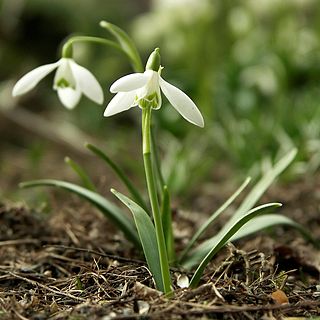
Galanthus, or snowdrop, is a small genus of approximately 20 species of bulbous perennial herbaceous plants in the family Amaryllidaceae. The plants have two linear leaves and a single small white drooping bell-shaped flower with six petal-like (petaloid) tepals in two circles (whorls). The smaller inner petals have green markings.
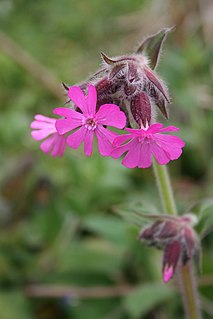
Silene is a genus of flowering plants in the family Caryophyllaceae. Containing nearly 900 species, it is the largest genus in the family. Common names include campion and catchfly. Many Silene species are widely distributed, particularly in the northern hemisphere.
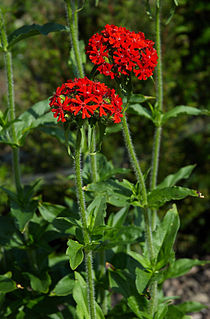
Silene chalcedonica, the Maltese-cross or scarlet lychnis, is a species of flowering plant in the family Caryophyllaceae, native to central and eastern Russia, Kazakhstan, Mongolia and northwestern China. Other common names include flower of Bristol, Jerusalem cross and nonesuch.
There are over 190 vascular plant species on the Norwegian Arctic archipelago of Svalbard. This figure does not include algae, mosses, and lichens, which are non-vascular plants. For an island so far north, this number of species constitutes an astonishing variety of plant life. Because of the harsh climate and the short growing season, all the plants are slow growing. They seldom grow higher than 10 cm (4 in)

Silene flos-cuculi, commonly called ragged-robin, is a perennial herbaceous plant in the family Caryophyllaceae. This species is native to Europe and Asia, where it is found along roads and in wet meadows and pastures. In Britain it has declined in numbers because of modern farming techniques and draining of wet-lands and is no longer common. However, it has become naturalized in parts of the northern United States and eastern Canada.

Galanthus nivalis, the snowdrop or common snowdrop, is the best-known and most widespread of the 20 species in its genus, Galanthus. Snowdrops are among the first bulbs to bloom in spring and can form impressive carpets of white in areas where they are native or have been naturalised. They should not be confused with the snowflakes, in the genera Leucojum and Acis.
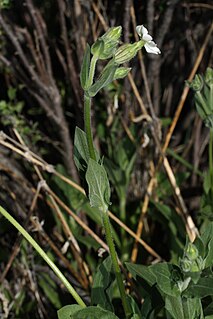
Silene latifolia subsp. alba, the white campion is a dioecious flowering plant in the family Caryophyllaceae, native to most of Europe, Western Asia and Northern Africa. It is a herbaceous annual, occasionally biennial or a short-lived perennial plant, growing to between 40–80 centimetres tall. It is also known in the US as bladder campion but should not be confused with Silene vulgaris, which is more generally called bladder campion.

Silene dioica, known as red campion and red catchfly, is a herbaceous flowering plant in the family Caryophyllaceae, native throughout central, western and northern Europe, and locally in southern Europe. It has been introduced in Iceland, Canada, the US, and Argentina.
Mating types are the microorganism equivalent to sexes in multicellular lifeforms and are thought to be the ancestor to distinct sexes. They also occur in macro-organisms such as fungi.

Microbotryum violaceum, also known as the anther smut fungus, was formerly known as Ustilago violacea. It is a Basidiomycete obligate parasite of many Caryophyllaceae. But it has now separated into many species due to its host specificity.
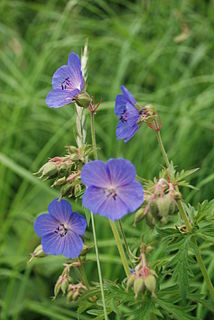
Geranium pratense, the meadow crane's-bill or meadow geranium, is a species of flowering plant in the family Geraniaceae, native to Europe and Asia. Forming a clump roughly 1 m (3.3 ft) tall and broad, it is a herbaceous perennial with hairy stems and lax saucer-shaped blooms of pale violet. It is extremely hardy to at least −20 °C (−4 °F), reflecting its origins in the Altai Mountains of central Asia.

Micranthes nivalis is a plant species in the saxifrage family. It is commonly called snow saxifrage or (ambiguously) alpine saxifrage.

The Alps are one of the great mountain range systems of Europe stretching approximately 1,200 kilometres (750 mi) across eight Alpine countries from Austria and Slovenia in the east, Switzerland, Liechtenstein, Germany, France to the west and Italy and Monaco to the south. The flora of the Alps are diverse. In the mountains, the vegetation gradually changes with altitude, sun exposure, and location on the mountain. There are five successive life zones, each with distinct landscapes and vegetation characteristics: premontane, montane, subalpine, alpine, and alvar.

Stellaria borealis is a species of flowering plant in the family Caryophyllaceae known by the common name boreal starwort. It has a circumboreal distribution, occurring throughout northern areas of the Northern Hemisphere. It occurs in many types of moist and wet habitat, including marshes, riverbanks, lakesides, floodplains, talus, ditches, and moist spots in forests and woodlands. It is quite variable in appearance, especially across subspecies. In general, it is a rhizomatous perennial herb forming mats of branching, four-angled stems lined with lance-shaped leaves a few centimeters in length. The inflorescence bears many flowers each with five deeply lobed white petals. Some flowers lack petals and have only the five pointed green sepals.
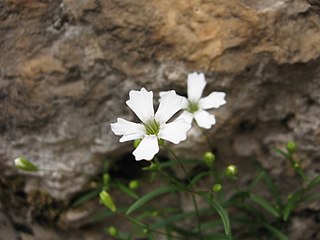
Heliosperma is a genus of flowering plants in the family Caryophyllaceae. As such, it is closely related to the large genus Silene, but its members can be told apart from Silene by the crest of long papillae on the seeds. The majority of the species are narrow endemics from the Balkan Peninsula, but H. alpestre is endemic to the Eastern Alps, and H. pusillum is found from the Cordillera Cantábrica in northern Spain to the Carpathians. Like members of the genus Silene and other related genera, Heliosperma is attacked by species of the anther smut fungus Microbotryum. Cases of parallel divergence events between alpine and mountain populations have been reported in this genus.

Microbotryum is a genus of fungi found in the family Microbotryaceae. It contains 89 species.
Microbotryum silenes-dioicae is a species of fungus first isolated from Brittany, France. Its name refers to its host species, Silene dioica. The fungus is the cause of anther-smut disease, which results in fungal spores replacing the pollen in the anthers. The species that most resembles ‘’M. silenes-dioicae’’ morphologically is M. lychnidis-dioicae.
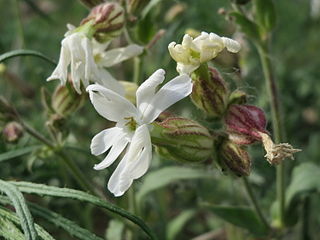
Microbotryum violaceum is a host-specific anther smut (fungus) disease that infects Silene latifolia and sterilizes the host plant. When infected with this disease, the flowers generate pathogenic spores, which can then be transferred to other plants by pollinating insects. Therefore, this disease is sometimes classified as a sexually transmitted infection.













